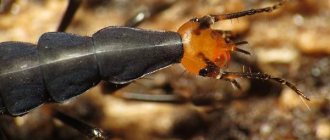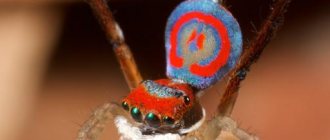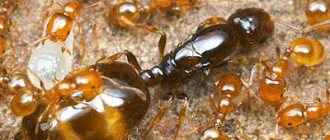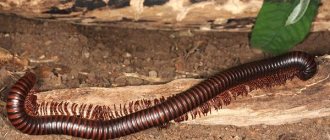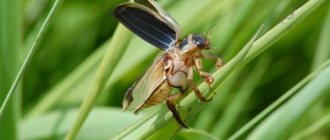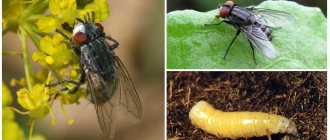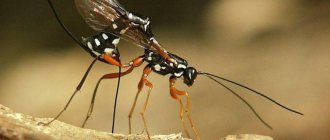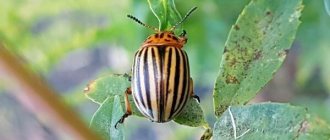№4
It is incredibly difficult to fight them due to their insane reproduction rate. In just one month, a female can lay up to 2000 eggs. Once the larvae hatch, they only need 10 days to become full-fledged flies.
By the way, the warmer it is, the faster they reproduce. Typically, one city trash can is enough to produce up to 1,000 new insects.
They have an incredible reproductive rate
A female fly can lay over two thousand eggs in just one month! These flying insects complete their life cycle from larva to adult in just 8 to 12 days. And the warmer the conditions, the faster the larvae hatch and grow.
Photo: UNL Department of Entomology
Flies undergo complete metamorphosis. Most species are oviparous. First, a sexually mature female lays eggs, and then small yellowish worm-shaped larvae hatch from them. They have no articulated legs. As the larvae grow, they molt repeatedly, shedding their entire shell. Later they develop into a pupa, which at the last stage of maturation becomes an adult.
№7
They are carriers of various diseases. Flies vomit their stomach juices onto the food, lay their larvae there, and walk on it with their dirty paws. The latter need to be discussed separately. Stomach juice and larvae are not the worst things these insects can give to a person.
But on their paws there are many pathogens, including Vibrio cholerae (the causative agent of cholera) and E. coli.
Moreover, in order to leave these pathogens on the food, the fly only needs to touch the product for a split second.
[edit] Flies and men in white
- Scientists are experimenting with genetic engineering on flies - adding, for example, skills to self-glow in the dark or an extra pair of legs. Thousands, millions, billions of fruit flies died for the sake of the progress of science and the development of genetic scientists. Due to their simple structure - only 8 chromosomes - they were very convenient to study. It's time to erect a monument. Although, to be more precise, scientists were primarily attracted not by the number of chromosomes, but by the speed of reproduction and ease of breeding these flies, when the result of the experiment can be seen in a matter of days. Drosophila larvae also have the so-called salivary glands. polytene chromosomes, characterized by their HUGE size, making them easy to look at and study. The purely arithmetic number of chromosomes played a role in cytogenetics experiments, when chromosomes were stained and their behavior was monitored using a conventional microscope. Still, 8 fly chromosomes are easier to see than 46 human chromosomes, especially not in a book, but on a preparation where they are all mixed up. Now that each chromosome can be colored with a separate dye, this is no longer relevant.
Here she is, a beauty, and here are her babies. Eating a baby cow
- The blowfly Cochliomyia hominivorax
troubles Pindostan cattle breeders because it likes to lay its larvae in wounds on the body of cows.
Accordingly, the larvae poison the wounds with their vomit, turning them into ulcers. Because of this, the little cow loses weight, there is simply no gain in milk yield, and the skin is worthless on market day. Then, at the instigation of the farmers, the evil fly-loving misanthropes studied the biology of these flies and came up with a savage way of fighting them, encroaching on the most sacred thing in a fly’s life - on the E
x. It turned out that a female blowfly can only mate once in its life, and that’s it. And then the insidious killers in white coats began to raise male blowflies on an industrial scale. They were well fed to make them more attractive to females, and then brutally irradiated with strong X-rays, causing the males to become infertile. Masses of sterilized males were then released into blowfly habitats. The pretty winged Don Juans successfully competed with skinnier wild males, sailed females, and... that’s all. Dynamo as it is. Females lost their virginity in exchange for bullshit instead of sperm, and that was the end of their contribution to reproduction. So the war between man and fly is sometimes sophisticated to the point of subtle perversion.
Details of the fly's epic fail in the English-language Pediwiki: tyts!
№8
They have a short lifespan. After the fly lays an egg, its offspring hatch within 24 hours. These offspring take about 10 days to become flies.
On average, they live about 30 days. However, their lifespan is greatly influenced by their environment and conditions. For example, at lower temperatures their life expectancy increases to 2 months. At higher temperatures it is around 30 days or even less.
She can live only 2-3 days without food.
[edit] Gallery
[edit] They are so different...
- Millions of these fruit flies died for the sake of science
- Know the heroes by sight!
- Bloodsucking Horsefly
[edit] Flies in high art
- Velomukha
- An example of a fly comic. The rest is there
- Another example from the same source
- And further
- Fly in high art
- Fly in the film of the same name
- Honorary All-USA Fly
- Magazine "Fly" with Cheburashko-ninja on the cover
- Zipper - green intelligent fly
- Fly from the 1960 domestic film adaptation
- Painting by Konstantin Khudyakov
- Polish artist Igor Morski
№12
They need a small area. You think about these insects flying all over your house, accompanying you outside, etc. In fact, studies have shown that they do not need much space. On top of everything else, they fly very slowly, naturally, if you don’t chase them with a sneaker. The average speed of a fly is 7 km/h, which is slightly more than the speed of a person.
Usually she covers a distance of no more than 1000 meters per day. On average, a person covers 3-4 km per day.
Who is a housefly?
When considering this term, it is worth mentioning two points of view. To begin with, this is an ordinary person who encounters winged insects and does not go into detail. Also, it is worth mentioning the position of a more enthusiastic person.
So, from a biologist's perspective, houseflies are a separate species that have a specific characteristic. During the summer, they live in close proximity to people.
It has a dark gray coloring and is large, but not the largest in size. Due to the soft proboscis, a bite is impossible, so the housefly has to feed on liquid food. Often attracted by food or waste products.
From the perspective of a common person, any creature with two wings that is in the house can be attributed to a housefly. It is unlikely that anyone is very keen on the presence of melon, cherry or raspberry flies.
This point of view is not surprising, because there is simply no need to know all types of flies - there are more than 150 of them.
Ilnitsa bee-eater
This is not a separate species, but just a subspecies of hoverflies. With a lot of names. This is both tenacious and just ordinary. The insect will be large and the length can often be up to about 1.5 cm.
The body is predominantly dark in color. The body is also characterized by the fact that it is covered with pubescence.
The larvae themselves, if they enter the human body, often cause serious intestinal disorders.
Tsetse fly
He is a resident of the African continent. The food for this dangerous predator is blood from wild mammals. Flies will only be carriers of the terrifying tryponosomas.
The disease that this tryponosome causes is one of the most dangerous and incurable. They lead to death due to the destruction of the nervous and immune systems.
What do flies eat?
Flies are omnivorous insects and can feed on any organic food. The flies pre-soak solid food with saliva. Sweet liquids and foods are especially preferred. Some types of flies are true “gourmets” and eat exclusively onions or carrots. Pyophyllides (cheese flies) reproduce only inside the head of cheese.
Interesting facts about flies
Despite the obvious harm and potential danger, flies are considered quite interesting insects:
- Since ancient times, some healers have used fly larvae to treat neglected wounds, using their ability to eat away dead tissue;
- flies were especially favored by the ancient Egyptians: the insect was considered a symbol of audacity and courage;
- The voracious larvae of hoverflies eat over 2 thousand aphids during their development.
Did you like the article? Share with your friends:
Diversity
In the modern period, taxonomies include about 40 thousand species of flies. The most common among them is home, or room. It is gray in color with a specific break in the wings. But the bright emerald fly, despite its visual attractiveness, is especially dangerous. This species lives exclusively on carrion and sewage.
Not all flies are associated with human life. For example, the hoverfly feeds exclusively on nectar. Outwardly, it is very similar to a wasp with transparent wings. But the fly, the description of which we will present now, is not at all a harmless creature. They call her Tsetse. This African species carries parasitic single-celled organisms called trypanosomes. They cause sleeping sickness, which is characterized by fever, weakness and unconsciousness.
So, a fly is an insect that is a representative of the Diptera order. A systematic feature is the presence of halteres. This structure is a modification of the second pair of wings, providing balance during flight. The average lifespan of flies is 20 days, and mayflies are 24 hours. Most species live near or inside human homes, feeding on human food. The negative significance of these insects is that they are carriers of dangerous diseases of humans and animals. Therefore, controlling flies and preventing their contact with food is an important requirement for hygiene.
Types of flies, names and photographs
There are 3,650 species of flies in the world, some of which are particularly common:
- house fly
a gray insect native to the Asian steppes. Distributed everywhere, most often near human habitation. Externally, many species are similar to the house fly, but it is distinguished by a special break at the edge of the wings. Under favorable conditions, the insect can live up to 2 months;
Housefly
- hoverfly (syrphid)
in appearance and habits it is similar to a wasp. The insect is distinguished by a black and yellow striped body and transparent wings. The hoverfly feeds on the nectar of flowering plants and is absolutely harmless. The fly got its name from the murmuring sound made by its wings when hovering;
Hoverfly
- green (carrion) fly
An insect with a shiny emerald body that lives near sewage and carrion. To avoid being eaten after mating, the male fly first offers the female some food;
Carrion fly
- common milkweed (tenacious) or bee-shaped milkweed
considered a subspecies of hover flies. A large insect, up to 1.5 cm long, with a dark-colored body covered with hairy pubescence. Beeworm larvae that enter the human body can cause serious intestinal disorders;
Ilnitsa vulgare
- ktyr
a large predatory fly that poses a danger to mosquitoes, midges, bees, and also similar flies. Killing various dangerous insects with a sharp sting and poison, tyri flies bring significant benefits to humanity;
Fly ktyr
- Tsetse fly
inhabitant of the African continent. The main source of nutrition for this dangerous predator is the blood of wild mammals, as well as livestock and people. Tsetse flies are carriers of trypanosomes, which cause an incurable disease that destroys the immune and nervous systems and leads to death.
Tsetse fly. Alan R Walker, CC BY-SA 3.0
Habitat
The fly, whose lifestyle we are considering in our article, belongs to the synanthropic species. This means that its existence is closely connected with man. Flies are especially interested in sewage - garbage cans, containers, rotting products, feces. It is these places that are most suitable for laying eggs, as they are rich in nutrients.
For humans, this insect poses a serious danger. The fact is that on the pads of her feet she carries the causative agents of many diseases - dysentery, cholera, typhoid fever. The difficulty also lies in the fact that harmful microorganisms are not broken down in the digestive tract, but are released outside in a viable form.
Characteristics of flies
Flies are carriers of pathogenic bacteria and dangerous infections. Fly larvae are capable of parasitizing any living organism, be it an animal or a human. Despite this, the familiar, annoying insect is an integral component of the biosphere and deserves every right to exist.
However, a fly is not always just dirt and unsanitary conditions. Some types of flies and their larvae are food for animals, while other types pollinate plants. Scientists have proven that the fly is endowed with a rare gene code with increased immunity that recognizes and destroys harmful cells. The discovery provides a chance to save humanity from many terrible diseases.
